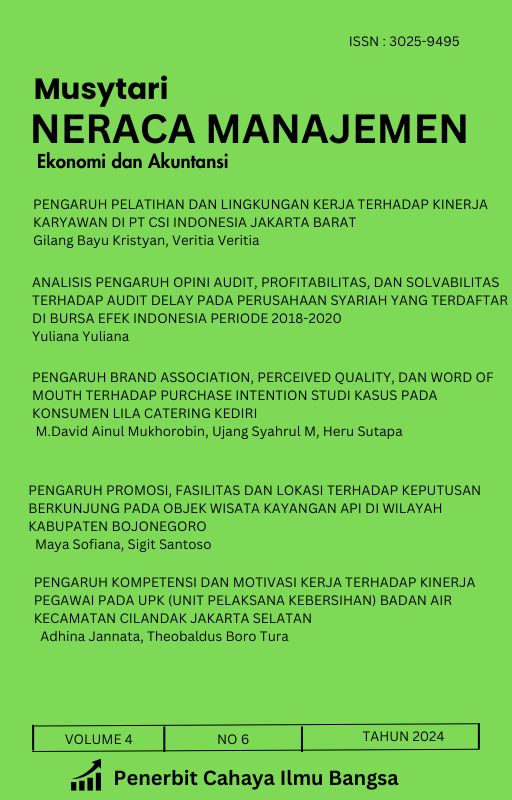ANALISIS PENGARUH INFLASI, TPT, DAN TPAK TERHADAP KEMISKINAN DI INDONESIA: PENDEKATAN MODEL ARDL
Published 2025-06-18
Keywords
- Inflation, Open Unemployment Rate, Labor Force Participation Rate, Poverty, ARDL Model, Indonesia
How to Cite
Abstract
This study aims to analyze the effect of inflation, open unemployment rate (TPT), and labor force participation rate (TPAK) on poverty levels in Indonesia for the period 1994–2023. Secondary data used comes from the World Bank and other official sources for 30 years. The Autoregressive Distributed Lag (ARDL) analysis method is applied to test the short-term and long-term relationships between variables. The results of the analysis show that inflation and TPT have a significant positive effect on poverty levels in both periods, indicating that increases in inflation and unemployment tend to increase poverty. Meanwhile, the TPAK variable has a negative but insignificant effect on poverty levels. These findings indicate that price stability and increased employment opportunities are key factors in poverty alleviation in Indonesia. This study provides important implications for policy makers to focus on controlling inflation and creating quality jobs in order to reduce poverty effectively.
References
- [1] Agustina, R. (2018). Pengaruh ekspor, impor, nilai tukar rupiah, dan tingkat inflasi terhadap cadangan devisa Indonesia. E-Jurnal Akuntansi STIE Mikroskil.
- [2] Anwar, R., & S. D. (2020). Pengaruh pengangguran terbuka dan inflasi terhadap kemiskinan di Indonesia. Jurnal Ekonomi dan Kebijakan Publik, 145–160.
- [3] Christianto, T. (2013). Determinan dan karakteristik kemiskinan di Provinsi Riau (Vol. VII, hlm. 78).
- [4] Erfiana, E., Iqbal, M., & Malik, A. (2025). Pengaruh human capital, produk domestik bruto (PDB) dan tingkat partisipasi angkatan kerja (TPAK) terhadap kemiskinan multidimensi di Indonesia dalam perspektif ekonomi Islam tahun 2004–2023. Jurnal Akuntansi, Manajemen dan Ilmu Ekonomi (Jasmien), 5(3), 56–67.
- [5] InflationTool. (2025). IDR inflation calculator – Indonesian Rupiah (1968–2025) [Data set]. Diakses dari https://www.inflationtool.com/rates/indonesia/historical
- [6] Jhingan, M. L. (2000). Ekonomi pembangunan dan perencanaan. Jakarta: Rajawali Press.
- [7] Jurnal Moneter. (2025). Analisis pengaruh tingkat pengangguran terbuka terhadap kemiskinan di Indonesia. Jurnal Moneter, 19(1), 50–65.
- [8] Kumalasari, M. (2017). Analisis pertumbuhan ekonomi, angka harapan hidup, dan partisipasi angkatan kerja terhadap tingkat kemiskinan di Jawa Tengah. Jurnal Ekonomi Pembangunan, 12(1), 34–46.
- [9] Mardiatillah, R. (2021). Pengaruh pengangguran dan inflasi terhadap tingkat kemiskinan di Sumatera Selatan tahun 2015–2019. Jurnal Ekonomi dan Bisnis Modern.
- [10] Muttaqin, M., & Anwar, K. (2023). Pengaruh inflasi, tingkat pengangguran terbuka, dan tingkat partisipasi angkatan kerja terhadap tingkat kemiskinan di Indonesia. Jurnal Ekonomi dan Kebijakan Publik, 2(2), 1–15.
- [11] Ningsih, D., & Andiny, P. (2018). Analisis pengaruh inflasi dan pertumbuhan ekonomi terhadap kemiskinan di Indonesia. Jurnal Samudra Ekonomika, 2(1), 53–61.
- [12] Prayoga, M. L., Muchtolifah, & Sishadiyanti. (2021). Faktor kemiskinan di Kabupaten Sidoarjo. Jambura Economic Education Journal, 3(2), 1–10. https://ejurnal.ung.ac.id/index.php/jej/index
- [13] Primandari, N. R. (2018). Pengaruh pertumbuhan ekonomi, inflasi dan pengangguran terhadap tingkat kemiskinan di Sumatera Selatan. Jurnal Ekonomi Pembangunan, 16(1), 1–10.
- [14] Purboningtyas, I., Sari, I. R., Guretno, T., Dirgantara, A., Agustina, D., & Al Haris, M. (2020). Analisis pengaruh tingkat pengangguran terbuka dan indeks pembangunan manusia terhadap kemiskinan di Provinsi Jawa Tengah [Laporan penelitian tidak diterbitkan]. Universitas Muhammadiyah Semarang.
- [15] Shelisa, I. I., & Setyanto, A. R. (2023). Pengaruh tingkat pengangguran terbuka (TPT) dan tingkat kemiskinan terhadap pertumbuhan ekonomi di Provinsi Lampung. Independent: Journal of Economics, 3(3), 89–100.
- [16] Susanto, R., & Pangesti, I. (2021). Pengaruh inflasi dan pertumbuhan ekonomi terhadap tingkat kemiskinan di Indonesia. JABE (Journal of Applied Business and Economic), 7(2), 271–278.
- [17] The World Bank. (n.d.). Labor force participation rate, total (% of total population ages 15+) [Modelled ILO estimate] – Indonesia. World Development Indicators. Retrieved June 18, 2025, from https://data.worldbank.org/indicator/SL.TLF.CACT.ZS
- [18] The World Bank. (n.d.). Nepal country profile. Performance in Practice (PIP). Retrieved June 18, 2025, from https://pip.worldbank.org/country-profiles/NP
- [19] The World Bank. (n.d.). Unemployment, total (% of total labor force) (modeled ILO estimate) – Indonesia. World Development Indicators. Retrieved June 18, 2025, from https://data.worldbank.org/indicator/SL.UEM.TOTL.ZS?locations=ID

